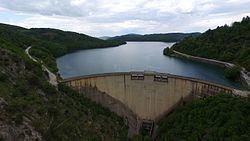Type of dam Concrete arch Width (crest) 220 m (720 ft) Height 83 m Operator Public Power Corporation | Opening date October 30, 1960 Impounds Tavropos (Megdovas) Construction began 14 December 1955 | |
 | ||
The Plastiras Dam (Greek: Φράγμα Πλαστήρα) is a concrete arch dam in Karditsa regional unit, Greece that impounds the Tavropos (Megdovas) River, creating an artificial lake respectively called the Lake Plastiras.
Contents
- Map of Plastiras Dam Itamos 430 67 Greece
- Name
- Background
- Construction and specifications
- Local impact
- References
Map of Plastiras Dam, Itamos 430 67, Greece
Name
The dam is named after Nikolaos Plastiras, a Greek General and Politician who was the first to visualize the construction of a reservoir in the Agrafa area as soon as 1925. He later boosted the efforts while serving as a Prime Minister, but did not live to see the construction of the dam.
Background
The river Tavropos was known in the area for causing flooding frequently. In late 1920s the idea of "constraining" the river flow was adopted by the incumbent Minister for Agriculture, but was met with opposition by both his political rivals and locals. Some of the concerns were the overall cost of the building and the impact a reservoir would have to the landscape. After the Second World War, the idea was revived by Prime Minister Nikolaos Plastiras and was also adopted by the Power Corporation. The Power Corporation included the construction of a dam in the area in its effort to electrify the Country. Numerous studies on the project where presented and in 1953 the French Omniun Lyonnais won the international contest for the construction of the Dam.
Construction and specifications
The building was officially founded on December 14, 1955, and the construction lasted for almost five years. The dam was dedicated on October 30, 1960. Plastiras Dam is an arched dam made of concrete, blocking a narrow point known as Kakavakia. The dam is elevated 795 m (2,608 ft) from sea level. It stands 83 m (272 ft) high and has a crest width of 220 m (720 ft). Its overall volume is 100×103 m³.
Local impact
The dam and the formed reservoir are protecting both the mountainous region of East Agrafa and the Plains of Karditsa from flooding. As a reservoir it provides irrigation water to the area and is also used to supply fresh water to the city of Karditsa and the surrounding villages. Moreover, the dam is equipped with two hydroelectric turbines that have a capacity of 130MW. Despite the original fears, the formation of the artificial lake is believed to be one of the few cases where the landscape was actually improved. The lake itself is a tourist attraction in Greece.The local economy was boosted since the 1980s due to visitors and many of the abandoned villages in the area have been revived.
The benefits of the use of the lake as a tourist attraction are so vast that the authorities have decided to limit the use of the reservoir for irrigation and electricity production purposes.
